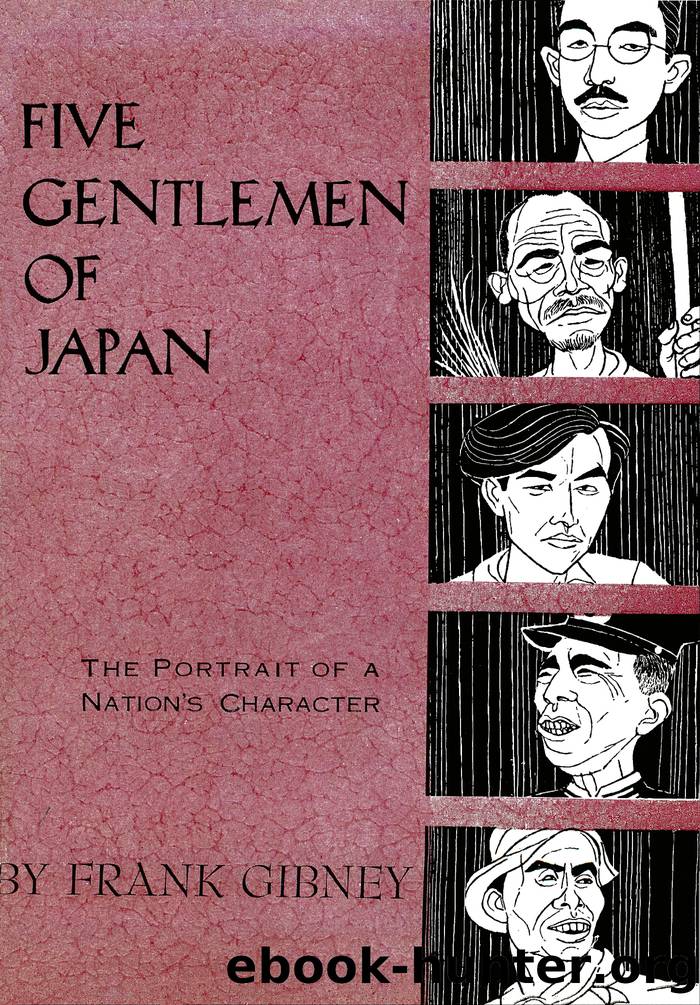Five Gentlemen of Japan by Frank Gibney

Author:Frank Gibney
Language: eng
Format: epub
ISBN: 9781462913336
Publisher: Tuttle Publishing
Footnotes
* I have purposely juggled and slightly falsified the circumstances of these three incidents, to avoid giving embarrassment to any of the men involved, all of them loyal and useful citizens of Japan.
* That is, if they could have endured the race prejudice which has thrived there. There are few meaner pages in modern American history than the record of Pacific Coast hostility to Japanese immigrants. The real cause for the anti-Japanese feeling was the fear that Japanese workers and farmers, used to working for far lower returns, would drive "native" Americans out of their jobs. This was disguised by all sorts of social, medical and political reasons. From 1900 to the start of World War II, the state of California led in enacting a sequence of restrictive measures against the Japanese immigrants, including segregation in the schools, and restrictions on ownership, or even the leasing of land by the Japanese. After the 1906 earthquake in San Francisco—when japan contributed more to the city's relief than all other foreign countries totaled—visiting Japanese scientists were stoned in the streets. In 1924 Congress passed the infamous Exclusion Act, to the satisfaction of California's civic groups.
The effect of this hostility on Japan was not lost. The existence of the Exclusion Act and stories of Japanese "second-class" citizenship on the Pacific Coast of the United States made it an easy job for the militarists to stir up anti-American feeling in the thirties. There is no doubt that California's attitude played its part in making the outbreak of war in the Pacific far easier than it might have been. Japanese-Americans who remained loyal to the United States during World War II were rewarded for their loyalty by being indiscriminately placed in desert jails, euphemistically called "relocation centers."
Happily, one effect of the war was to scatter the Japanese population throughout the country. They have in this way been better able to assimilate themselves to the larger American community.
* Japanese aircraft production for the month of June, 1944, its peak, was 2,541 planes; by June 1945, it had dropped to 1,340; by July, to 1,131. This was at a time when operational losses exceeded the total factory output.
Download
This site does not store any files on its server. We only index and link to content provided by other sites. Please contact the content providers to delete copyright contents if any and email us, we'll remove relevant links or contents immediately.
| Africa | Americas |
| Arctic & Antarctica | Asia |
| Australia & Oceania | Europe |
| Middle East | Russia |
| United States | World |
| Ancient Civilizations | Military |
| Historical Study & Educational Resources |
The Sympathizer by Viet Thanh Nguyen(4305)
The Rape of Nanking by Iris Chang(4137)
World without end by Ken Follett(3428)
Ants Among Elephants by Sujatha Gidla(3417)
Blood and Sand by Alex Von Tunzelmann(3138)
Japanese Design by Patricia J. Graham(3109)
City of Djinns: a year in Delhi by William Dalrymple(2514)
The Queen of Nothing by Holly Black(2492)
Foreign Devils on the Silk Road: The Search for the Lost Treasures of Central Asia by Peter Hopkirk(2433)
India's Ancient Past by R.S. Sharma(2416)
Inglorious Empire by Shashi Tharoor(2395)
Tokyo by Rob Goss(2389)
In Order to Live: A North Korean Girl's Journey to Freedom by Yeonmi Park(2345)
India's biggest cover-up by Dhar Anuj(2318)
Tokyo Geek's Guide: Manga, Anime, Gaming, Cosplay, Toys, Idols & More - The Ultimate Guide to Japan's Otaku Culture by Simone Gianni(2314)
The Great Game: On Secret Service in High Asia by Peter Hopkirk(2305)
Goodbye Madame Butterfly(2203)
Batik by Rudolf Smend(2123)
Living Silence in Burma by Christina Fink(2038)
